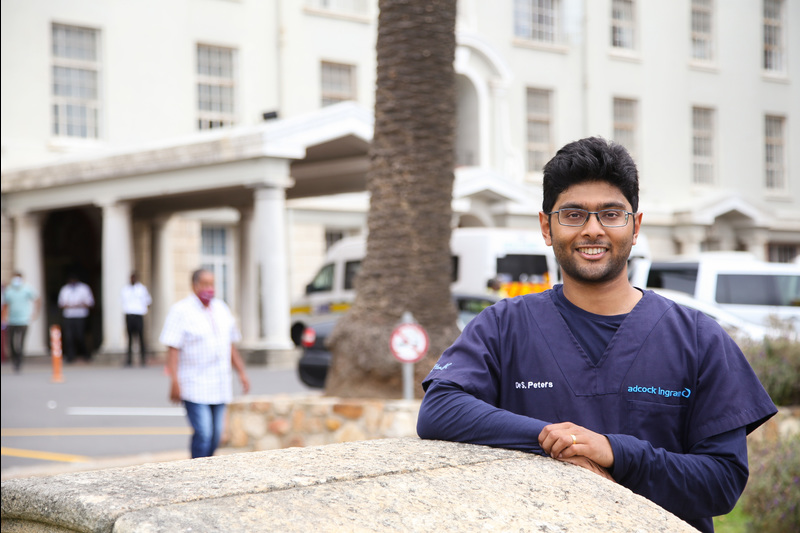Critical care
23 January 2021 | Story @HeroesofGrooteSchuur. Photo Je’nine May. Read time 5 min.
Ensuring that theatre services run optimally and smoothly requires a lot of day-to-day planning, particularly with regard to securing enough Intensive Care Unit (ICU) beds. With the COVID-19 crisis, this has been taken to another level. In a short space of time, we have had to de-escalate theatres, we’ve had to shift staff members around, and we’ve had to decrease the number of theatre lists we are running so that we can get more staff into ICU. We had to scale up our ICU beds quite substantially, which we were able to do successfully, but only through hard work and the determination of staff.
ICU beds have always been in short supply, and clinicians have been forced to make very difficult decisions on the floor to ration the resource. At the peak of the first wave, we increased the number of ICU beds from the ‘normal’ 25 to 63 ICU beds – this is double the amount available in the entire Nelson Mandela Bay Metro. In the second wave, if also counting the beds that offered high-flow nasal oxygen (HFNO), we easily reached 100 beds.
“The greatest positive outcome of this pandemic is the amount of teamwork, and the appreciation of systems thinking in Medicine that it has engendered.”
Each additional bed requires a scramble. We have experienced Friday afternoons where we’ve had to convert empty six-bed units into an ICU. This requires a range of expensive equipment to be procured; syringe drivers, infusion pumps, beds and suction. Most importantly, we still need to staff these units with nurses, doctors, clinical technologists and general workers - which is why every life saved in ICU has really required major investment.
Supported by UCT research infrastructure, we have also run a large number of high quality research trials, and have adapted our practice accordingly as evidence became available.
It hasn’t been easy, and the mortality rates are a lot higher than for your typical ICU patients. Clinical staff have been bearing the brunt and are doing fantastic work, but it’s not easy to work through this disaster. We’ve had to stretch our staff. We’ve pulled people out of main theatre anaesthetizing to go to ICU. We’ve created an anaesthetic intubation team, which services the whole hospital, making sure that when patients decompensate there’s someone available to safely intubate and transfer them to ICU. This is world-class care. The team have had more than 300 intubations – which are high-risk procedures where you’re visualizing and cannulating the throat of someone with coronavirus.
At night, each ICU registrar is looking after up to 18 ICU patients, as opposed to the usual 12. And the nurses who are used to seeing patients one-on-one are having to split themselves to three patients which is also very difficult because they have to mix drugs, they have to feed patients, they have to write up orders. It’s a lot of work. Anaesthetic registrars and consultants, alongside theatre nurses, have staffed the emergency theatres on skeleton staff through busy weekends and nights.
At the height of each wave, we open a new six-bed unit every week and nurses just aren’t available - we’re making do with what we have. The people who are doing the work are obviously passionate about their work and they’re aligned to the hospital’s vision of being proudly Groote Schuur Hospital (GSH). Perhaps unsurprisingly for medical professionals, what we’ve found is that people are willing to put themselves at risk, if you allow them to work within their chosen scope of practice, where they can make maximal difference to patient outcomes. And so it’s been about allowing creativity and innovation at the floor level and then being able to harness that to the best outcomes in the system.
Healthcare management – it’s up and down. You get days where it feels like everything is crashing. But you have to re-define what success looks like. Now, success is just running the course with one’s team, making sure that you are effecting patient care and saving the lives that you still can.
The management of healthcare facilities in South Africa has never been an easy task, but the pandemic has thrown the entire service platform into disarray. Unlike the first wave, during which we had clear policy directives from national and provincial authorities, the second wave presented a struggle to maintain normal services – until it became impossible to do so any further. We face a similar challenge for successive waves, with decreased budgets in the new financial year.
“This will be another difficult year, but I continue to believe that the future is bright. We will build back the service stronger and more resilient.”
But the greatest positive outcome of this pandemic is the amount of teamwork, and the appreciation of systems thinking in Medicine that it has engendered. Public Health Medicine has been at the forefront of the systems response throughout the pandemic. For the first time, we have been able to engage and support our clinical colleagues directly by demonstrating the ‘bigger picture’; providing them with statistical analyses, disease mapping and coordinated management.
This will be another difficult year, but I continue to believe that the future is bright. We will build back the service stronger and more resilient. There has never been a better opportunity to say to ourselves, ‘What should our service look like?’ And then make it happen, together.
 This work is licensed under a Creative Commons Attribution-NoDerivatives 4.0 International License.
This work is licensed under a Creative Commons Attribution-NoDerivatives 4.0 International License.
Please view the republishing articles page for more information.










